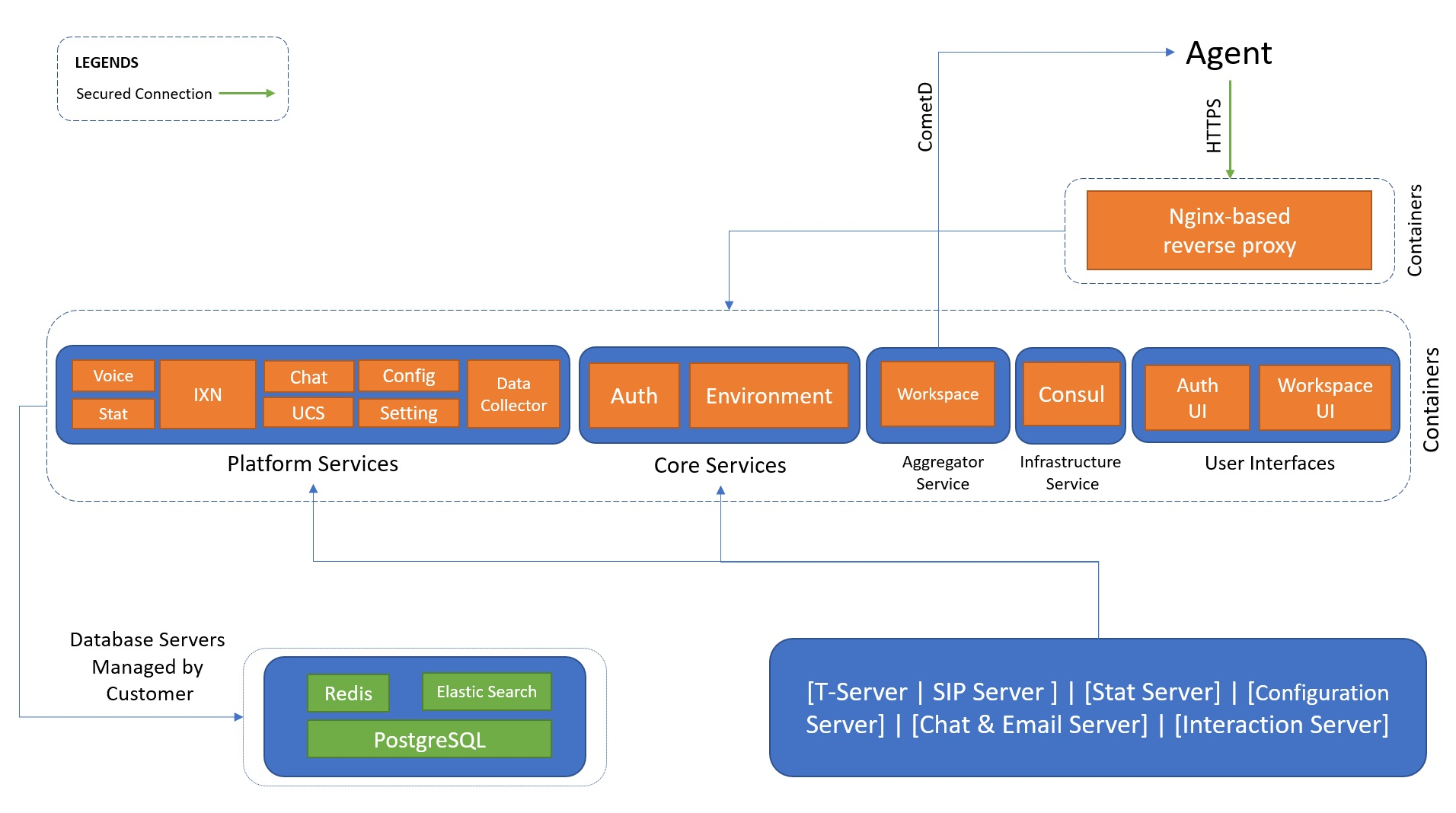(Created target blank page For Version: HTCC:9.0.0) |
(Update with the copy of version: 9.0.0DRAFT) |
||
| Line 1: | Line 1: | ||
| − | <!-- | + | = Architecture of Web Services and Applications = |
| + | |||
| + | [[File:GWS_new1.png]] | ||
| + | |||
| + | '''Description of the preceding diagram''' | ||
| + | |||
| + | Genesys Web Services (GWS) is an application cluster composed of several microservices that run together. GWS runs on multiple Containers that are categorized as below: | ||
| + | * Data Services: This service use multiple data source (third-party databases) to store GWS data. These databases should be maintained by customers. | ||
| + | * Platform Services : These services are used to connect to Genesys servers such as Configuration Server, Stat Server, SIP Server, and Interaction Server. | ||
| + | * Core Services : These services are used to interface with Genesys configuration and authentication. | ||
| + | * UI Services: These services provide user interfaces (Workspace Web and Application Splash page with login UI) and underlying service to drive the interfaces (Workspace Service and Data Collector). | ||
| + | |||
| + | Reverse Proxy Service is used as an Ingress Controller. This works as an internal Application Load Balancer (ALB). | ||
| + | |||
| + | == CometD== | ||
| + | Web Services uses CometD version 3, an HTTP-based routing bus that uses an Ajax Push technology pattern known as Comet. Comet is a web application model that allows an HTTP request to push data to a browser, even if the browser has not requested it. | ||
| + | |||
| + | Web Services uses CometD to deliver unsolicited notifications to clients for real-time events, such as getting a new call or chat message. At runtime, CometD delivers messages, providing clients with a consistent approach while maintaining support for multiple browsers. | ||
| + | |||
| + | {{NoteFormat|Web Services and Applications does not currently support web sockets.}} | ||
| + | <!--For example, if the browser supports websockets, the websocket transport would be selected when the connection is negotiated. If the browser does not support websockets, other techniques such as long polling can be used to provide the same result.--> | ||
| + | |||
| + | For details about CometD, see [http://cometd.org/ http://cometd.org/]. | ||
| + | |||
| + | <!-- For details about how to configure CometD in Web Services, see [[HTCCConfigurationOptionsReference#cometDSettings|cometDSettings]]. --> | ||
| + | |||
| + | [[Category:V:HTCC:9.0.0]] | ||
Revision as of 16:50, February 19, 2020
Architecture of Web Services and Applications
Description of the preceding diagram
Genesys Web Services (GWS) is an application cluster composed of several microservices that run together. GWS runs on multiple Containers that are categorized as below:
- Data Services: This service use multiple data source (third-party databases) to store GWS data. These databases should be maintained by customers.
- Platform Services : These services are used to connect to Genesys servers such as Configuration Server, Stat Server, SIP Server, and Interaction Server.
- Core Services : These services are used to interface with Genesys configuration and authentication.
- UI Services: These services provide user interfaces (Workspace Web and Application Splash page with login UI) and underlying service to drive the interfaces (Workspace Service and Data Collector).
Reverse Proxy Service is used as an Ingress Controller. This works as an internal Application Load Balancer (ALB).
CometD
Web Services uses CometD version 3, an HTTP-based routing bus that uses an Ajax Push technology pattern known as Comet. Comet is a web application model that allows an HTTP request to push data to a browser, even if the browser has not requested it.
Web Services uses CometD to deliver unsolicited notifications to clients for real-time events, such as getting a new call or chat message. At runtime, CometD delivers messages, providing clients with a consistent approach while maintaining support for multiple browsers.
For details about CometD, see http://cometd.org/.

